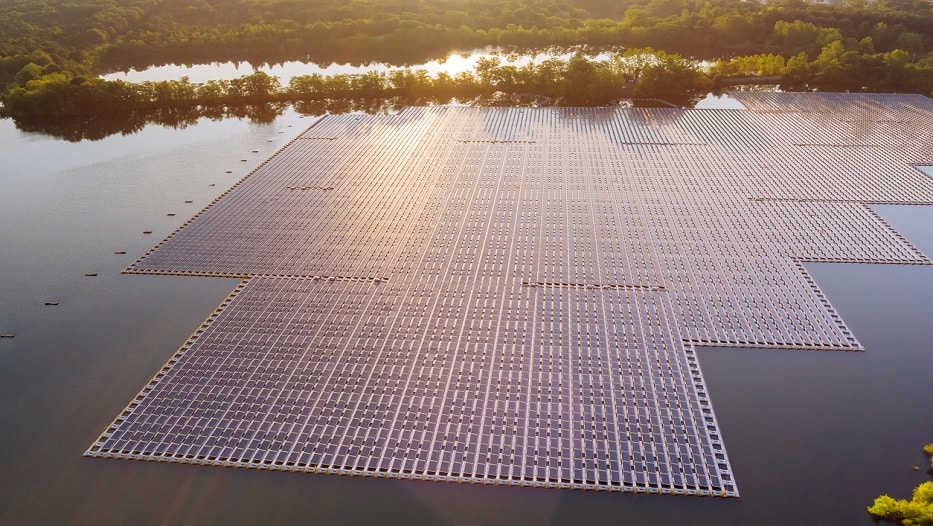Floating photovoltaic installations represent a new breakthrough in solar energy. More than a hundred major Spanish reservoirs could be home to this type of plant, according to the future Royal Decree presented by the Ministry for Ecological Transition and Demographic Challenge (MITECO), which would mean an increase in installed power in terms of renewable energy. We take a look at the present status and the future of this promising energy source.
We are increasingly accustomed to seeing solar panels on roofs of homes and other buildings, as well as on large stretches of land. In the near future, it will also be common to see them on reservoirs and other water bodies.
We are talking about floating photovoltaic generating plants, an emerging form of technology that, as the name implies, has panels capable of floating on the surface of drinking water reservoirs, lakes and dams, among other locations, and opening up a new horizon for solar energy, one of the most well-established renewable sources.
Experience at a global level
Although its development is fairly gradual, floating photovoltaic energy already has more than a decade of history in different parts of the planet. In actual fact, the first installations emerged in 2007. In recent years, the pace of growth has accelerated, together with technical, scientific and ecological knowledge about its use.
Today, the majority of such installations are concentrated in Asia, which is leading this trend of floating solar energy. Large-scale projects exist in China, Korea, Singapore, and Japan, and there are also examples in the United States, Canada, as well as Australia. In Europe, solar plants in France, Switzerland, the Netherlands and Portugal have already seen – or will soon see – the light of day.
Expectations are positive. According to data from the World Bank, this technology could soon double installed capacity in terms of solar power, taking into account the many man-made water deposits, such as swamps and reservoirs, that exist on a global scale.
Spain joins the race
In the current decade, our country is experiencing the deployment of renewable energy. The goal is a market penetration that enables 42% of end-user power consumption and 74% of all electricity generation to originate from these sources by 2030. Opportunities for alternative formulas are opening up in this race.
The Ministry for Ecological Transition and Demographic Challenge (MITECO) has begun the development of a regulatory framework for photovoltaic plants in state-owned public water bodies, a move that is part of a package of approved measures to respond to the economic and social consequences of the war in Ukraine.
Until now, floating photovoltaic plants have been only operating in small reservoirs or on artificial rafts in Spain, mainly intended for self-consumption (to power irrigation systems in the agricultural sector).
The Government’s plan is to explore the possibility of installing these plants in more than a hundred major reservoirs and other state-owned water bodies, such as canals or desalination plants, through operating concessions with a maximum term of 25 years.
Currently in Spain there are 106 state-owned reservoirs on which this type of installation could be located, spread among the major waterways. Specifically, there are 28 reservoirs in the Guadiana basin; 24 in the Guadalquivir basin; 20 in the Tajo basin; 19 in the Ebro basin; six in the Jucar basin; five in the Segura basin; three in the Duero basin; and one in the Miño-Sil basin.
Projects must overcome a long list of technical requirements
in order to avoid possible impacts on water quality and ecosystems
Hand-in-hand with hydroelectric power
Another of the lines of development being contemplated in Spain is the location of photovoltaic plants next to hydroelectric power stations. This location makes sense for several reasons: the first being to use solar capacity to increase the existing plant’s electricity production. However, also to optimize the use of water outflow infrastructure, as well as helping to manage power generation during periods of water shortage, when the generation of hydroelectric power decreases.
To make this new type of installation possible, however, projects must overcome a long list of technical requirements in order to avoid possible impacts on water quality and ecosystems, as well as having monitoring programs in place, as detailed in the proposal for a royal decree submitted by the MITECO.
The regulations include, for example, a maximum of three plants per reservoir and a partial coverage according to the trophic status of each: the worse the quality of its water, the greater its coverage may be.
Pros and cons
There is no doubt that floating solar installations will increase the capacity of renewable electricity generation in Spain, speeding-up the energy transition and the decarbonization of our economy.
Furthermore, in its explanatory memorandum, MITECO also highlights other potential benefits, such as “the reduction in evaporation, as solar panels provide shade and limit the effect of evaporation, which is understood to be of special importance in arid environments, in addition to effects such as a reduction in, or elimination of, the shading of the panels by their surroundings, or the reduced need for significant ground preparation.” Likewise, it adds, “the shade provided by these floating solar-panel sites also helps reduce the presence of algae blooms in freshwater bodies.”
Among the challenges to be faced, as an emerging technology, it will be necessary to assess the ecological impact on the water ecosystem and increase knowledge and testing of floating photovoltaic power plants.
Keep reading… Biojet: moving towards sustainable aviation





